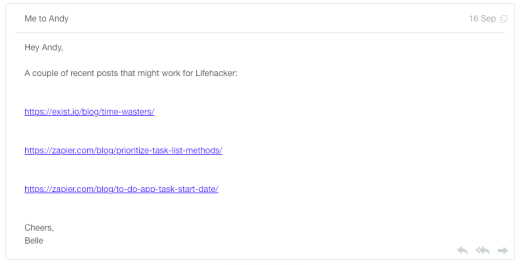
When people ask for my credentials as a content writer, I often share (well let’s be honest—I boast) that my work has been published on Fast Company, Inc, Entrepreneur, Salon, and more. In fact, a lot of that publishing was re-publishing.
Since my work tends to end up on various sites that I don’t actually write for, I’ve had many people ask me how that happens and how it’s useful.
What is content syndication?
Writers and editors tend to use the terms “syndication” and “republishing” interchangeably to mean the process of publishing the same content on a different site. Generally the content remains exactly the same, with an additional comment from the republishing editor to explain that the post is republished (and link back to the original).

Republishing usually happens in one of two ways: either as a one-off agreement to republish a single piece, or as an ongoing agreement to republish any new content from a particular writer or blog.
Some editors with ongoing agreements will reach out to their writers when they see a piece they want to republish. In other cases, the writer will send appropriate pieces to their republishing editors for consideration.
Natt Garun, The Next Web‘s US editor, and former commissioning editor, says TNW usually starts with one-off syndications:
…if the partnership works out we can continue to republish on a normal basis given that the submitted content remains relevant for our readers.
What’s it good for?
So why would you bother having your content republished? There are a few reasons it can be really beneficial for writers.

More exposure
It takes a long, long time to build an audience for your blog. And even as your audience grows, there are always more people you’re not reaching.
Having your content republished on another site lets you reach their audience. Natt told me republishing on The Next Web can give writers international exposure they might not get on their own.
Our top readerships are in the US, Europe, and India and we promote the posts on our social networks which have a pretty strong following. With readers round-the-clock, it’s a great way to showcase content to everyone around the world
Getting more mileage from your content
Unlike guest posting or writing commissioned work for other sites, republishing lets you re-use content you’ve already written. You put the effort in once, for your own blog, and as a bonus you get to reach more people with that same content.

Paul Jarvis, founder of Creative Class, makes his mailing list a priority, always writing content first for his list and offering it up for syndication afterwards. This lets Paul focus on his main audience while getting more mileage from his content through syndication.
Getting people back to your blog
Most republished pieces will include a link back to the original content. While this is as it should be, few readers click those links in my experience. What happens more often is readers click on relevant inline links to get more information. If these happen to be links to other content on your blog (it should go without saying, but don’t do this unless it’s actually relevant), you can increase visits to your blog this way.
For instance, I wrote a post for the Exist blog that was published on Lifehacker recently titled Tracking your habits: why you should, and how to do it well. I’d previously written a post for the Exist blog titled Apps to track your habits and goals, which I linked to in this more recent post about tracking habits.

When the tracking habits post was republished on a Lifehacker with a link back to the original on the Exist blog, here’s how many visits each of those posts got:
- Apps to track your habits and goals: 5,361
- Tracking your habits: 1,516
That’s 350 percent more referral traffic to the inline link than to the original post. Which makes complete sense when you think about it: if you’ve just read the whole post on Lifehacker, why would you need to click through to the original version if it’s the same thing? But the inline link to a list of habit-tracking apps is relevant to the reader—it comes at the end of the post after I’ve told you how to track your habits and why you should.
Who should do it?
Republishing won’t work for everyone. In my experience, it’s best used if you fit into these buckets:
You’ve already built a name for yourself
If nobody knows who you are you’ll have a much harder time getting attention from editors. Not only will you have trouble getting an introduction to them or having your cold email noticed, but you’ll also be missing any social proof that your content is high quality and people find it useful.
When you’ve built a name for yourself, your audience size and engagement can speak for you to tell an editor who’s finding your content useful and how popular it is.

You’ve already got relationships with editors
If you know editors at the publications you want to see your work in, you’ll have a much easier time getting started. Editors are busy, and their inboxes are full. They’re not likely to notice a cold email from someone they don’t know.
It really is all about connections – just like any other aspect of business, it’s mostly who you know. — Paul Jarvis
If you don’t know any editors yet, getting a warm intro from someone you do know can help you start building those relationships.
Paul Jarvis told me about an experiment he tried to test how important warm intros really are:
…at a time when I was already writing for many business publications (and already a bestselling author), I emailed 40 publications through their “Have content? Submit it here!” links. I heard back from only one. Whereas when someone makes an intro to a publication saying that I could potentially contribute, I’ve never heard a single no.
Andy says he usually focuses on writers he already has a relationship with when looking for content to republish. With so much content available and so little time, Andy says relying on existing relationships is the most efficient option for him.

I am also lucky to have a wide variety of people approaching me with articles they want to publish, but it’s rare that an unsolicited pitch bares any fruit.
You’re creating content regularly
Republishing tends to give you a spike in traffic and engagement. The thing about spikes is that they don’t last. So republishing can help if you do it regularly and you’re doing it on top of your main content strategy.
If you’re creating content regularly you’ll also have more to offer editors you work with.
How to get started
Assuming you fit into those buckets, how do you go about getting your content republished? Here’s what I’ve found to be most useful.
Offer value
The reason republishing happens at all is that editors need more content. And by republishing yours, they get it for free.
Andy Orin is a writer for Lifehacker, and handles most of the guest articles published on the site. Andy told me there are two main reasons he finds republishing useful for Lifehacker:
When I see someone writing about something interesting that we haven’t covered before, or that our staff writers perhaps aren’t well-versed in, it’s cool to bring in an outside perspective to add some variety between our other posts. I don’t really care that it’s been seen elsewhere.
The broader reason, though, is less interesting: I don’t always have enough writers of my own to fill the publishing schedule and need guest writers or republished posts to fill the gaps. I try to only use the best articles I can find, obviously, but it’s like running a daily newspaper; we’ve got to fill the page with something, and hopefully it’s something great.
So make sure your content is high quality and useful. You should be offering something valuable to the readers of each publication you reach out to—remember, the editors you talk to are thinking about their readers, so when you talk to them you should be too.

Make it easy
If you want busy people to help you, you need to make it as easy as possible. This means doing as much work for the editor as you can, and making their job easy.
I usually send an email that looks something like this:

(Once I have an ongoing relationship with an editor I keep my emails short and to-the-point because they’re so busy.)
I’ve chosen the content for them, I’ve given them the link, and in some cases I’ll suggest an alternative title that fits better with their site. All the editor has to do it say yes or no, and take the content I’ve offered.
As Andy says, “Because I can’t devote a huge amount of time to reading every article on the internet, it’s very helpful to have standing agreements with authors and outlets that I use repeatedly.”
Target your content
It’s unlikely that all of your content will be a perfect fit for another site. Whether it’s just different topics, different approaches, or because you’ve already republished a piece elsewhere, you’ll need to carefully choose the content that fits each publication.

Natt from The Next Web says writers pitching to be republished should be sharing content that will work for the TNW audience:
In pitches, we look for content that is fresh, interesting, brand-agnostic (anecdotes are fine) and well-written, and most importantly, resonate with our readership.
For each editor you email, you should be sending them only content that you believe fits their site. As you build on your relationship, they’ll come to trust you to understand their audience and only offer the most relevant content. This makes their job even easier, because they can leave more of the effort of choosing pieces up to you.
Every editor I know is busy as hell. If I can send them clear pitches that are on point with their publication’s topic and style, it’s easy for them to say yes. — Paul Jarvis
For Buffer content crafter Courtney Seiter, feedback from editors helps her tailor future pitches more successfully.
I try to ask for feedback early and often on whether my pitches are hitting the mark, if they want content in any particular direction, and how often they want to be in touch. One magazine Buffer syndicates with told me that articles that include avocados always perform amazingly well for them—there’s definitely no way I could have ever known that than by going to the source.
Keep them in the loop
The more you keep in touch with your editors, the more easily they’ll remember you and the stronger your relationship will be. If you’re regularly writing content that fits well with a particular site, keep them in the loop—even if they don’t always republish your work. They’ll appreciate having a stream of high-quality content to choose from.

Just make sure you’ve got a strong relationship and they’re comfortable with you sending regular emails before you do so. Sending regular cold emails won’t go down well with a busy editor.
Courtney Seiter says sometimes polite persistence is needed early on. “Pretty much everyone working in media tends to have a full to overflowing inbox, so it can sometimes take a while to get a good rhythm going.”
It helps to keep track of who you’ve pitched each piece of content to, as well. Paul Jarvis uses a spreadsheet to keep track of what content he’s pitched and to whom. I use MeisterTask to keep track of all the content I write, and add notes to each post’s card when I pitch it to someone. Find a system that works for you so you don’t end up double-pitching or forgetting to pitch your work.
Building your brand
Here’s a final point to help you out if you’re not ready to have your work republished yet. In particular, if you haven’t built relationships with editors yet.
One way you can do this is via guest posting. Guest posting can be done for free (in return for exposure) or on a freelance basis, and requires you to create original content for other sites.

The good thing about guest posting is that original content has a greater value than republished content, so if you don’t have much of an audience yet, this is something you can offer other sites to build up your name and improve the social proof that your content is Good Stuff.
Paul Jarvis used this method to build his relationships with publications that now syndicate his content. Paul wrote a mixture of paid content, which he created exclusively for that publication, and free guest posts, which he shared on other sites after a period of exclusivity. In either case, Paul says providing original content first enabled him to discuss syndication options with those editors later.
Paul was also strategic about getting to know writers and editors at the publications he wanted to write for.
I wasn’t slimy or pitchy about it, I just interacted with them because they were doing what I wanted to and writing about topics I was actually interested in.
He also made a point to ask for advice from people he knew who were already contributing to the publications he was targeting. “If it was somewhere I also wanted to write, I’d ask them if I could find out a little about the process from them,” Paul says. In some cases these people would offer to make introductions for him, which Paul says helped a lot in forming those early relationships.
What about SEO?
You might be wondering by now how syndication will affect your content’s search engine rankings. This is worth thinking about if your blog is new, or small, and you’re publishing on an established site, as their existing prominence with search engines could help their version of your content rank higher than the original.

If your site is well-established you may not need to worry as much, but there are a few things to keep in mind to mitigate the SEO risk of syndication:
Make sure the syndicated content links back to your original piece. Most of the publishers I’ve worked with do this as a matter of course, but when you’re setting up new syndication agreements double-check that each piece will include a link to the original.
Ask for a rel=canonical tag. Just like a link back to the original piece, a rel=canonical tag can help search engines work out which piece should get better rankings when comparing the same content on different sites. This HTML tag goes in the syndicated version of your content to tell search engines where to find the original content, so you might not always be able to get editors to implement this for you.
Thankfully, since it’s the easiest and most common attribution approach for syndicated content, Google’s own Matt Cutts says linking back to your original content from a syndicated version can help Google figure out which page to give the better rankings to.

If you’re thinking about getting into republishing to get more mileage from your content and reach a bigger audience, keep in mind that editors are busy, busy people. They need more content to keep their readers happy, so make sure you’re providing value every time you reach out.
And above all, remember that this process is built on relationships.
Read Next:
Image credit: Shutterstock
This post first appeared on ghost.org
Get the TNW newsletter
Get the most important tech news in your inbox each week.




